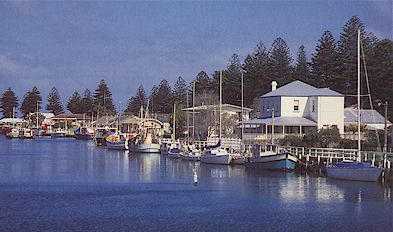This story has now been exposed as a historical myth by Jenny Fawcett, in her new book Captain Henry Wishart of Port Fairy Bay, detailed
The Moyne River harbour is at the heart of Port Fairy, providing a safe anchorage for both fishing boats and pleasure craft. It is now a thriving tourist destination.
Jenny Fawcett's alternative Jenny's research on Henry Wishart includes his discovery of Lady's Bay near Corner Inlet, and his time ashore at Western Port in
1826. Her book also follows Wishart's service in the sealing and whaling industries and provides an account of his being held hostage
by Taranaki natives in New Zealand. It includes accounts of Isaac David Nichols, the Fairy's owner and son of Australia's first official postmaster, who accompanied Wishart to Port Fairy.
For several years Captain Wishart returned to this haven, and soon other sealers and whalers were using it. Many of them built small
cottages along the river, thus founding the town, and some have been carefully preserved. By the mid-1800s Port Fairy was the
second busiest seaport in Australia, after Sydney. The quaint Caledonian Inn, pictured below, also dates from the period and is said to be the oldest continuously licensed hotel in Victoria. It seems likely that early historians knew that Port Fairy was named after the cutter
Fairy by the Captain Wishart who discovered it - they just couldn't remember his name. Perhaps Henry Wishart was related to a James Wishart? We also know of a
Thomas Wishart working as a whaler from Tasmania. It would be interesting if they were all members of the same whaling family.
We are currently planning to commemorate the founding of Port Fairy by Captain Henry Wishart in some substantive way - possibly at the Caledonian Inn (above).
Therefore, if anyone reading this can shed further light on the history of Port Fairy, or the Wishart whalers or sealers of Tasmania, please get in
|


 There is a myth, widely reported, that a Captain James Wishart
sailed his whaler the Fairy into a little bay in south-west Victoria, Australia, to shelter from a storm in 1810. There he discovered a safe anchorage at the mouth of a river, later named the river
Moyne. Returning there on subsequent whaling expeditions, as is often stated, James Wishart eventually founded the picturesque fishing village of Port Fairy (pictured above) which is named after his ship.
There is a myth, widely reported, that a Captain James Wishart
sailed his whaler the Fairy into a little bay in south-west Victoria, Australia, to shelter from a storm in 1810. There he discovered a safe anchorage at the mouth of a river, later named the river
Moyne. Returning there on subsequent whaling expeditions, as is often stated, James Wishart eventually founded the picturesque fishing village of Port Fairy (pictured above) which is named after his ship.
